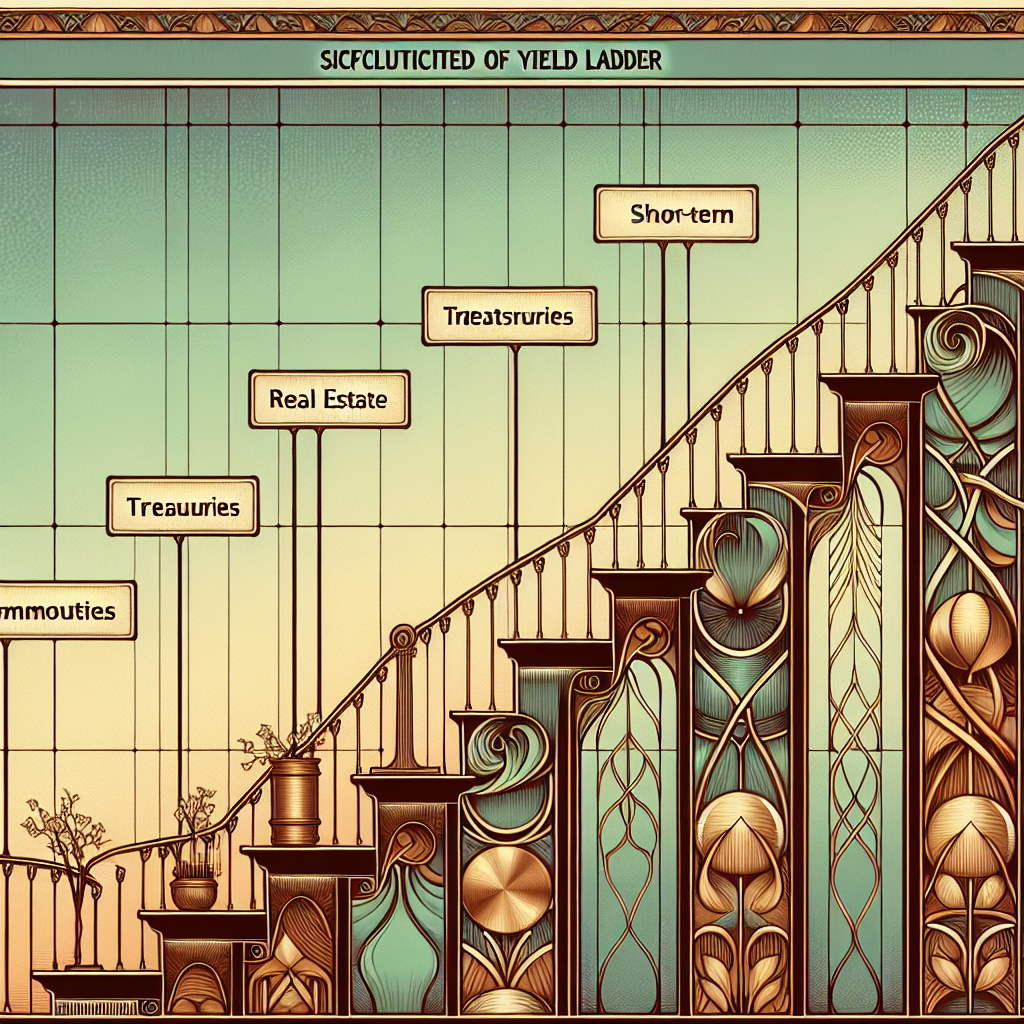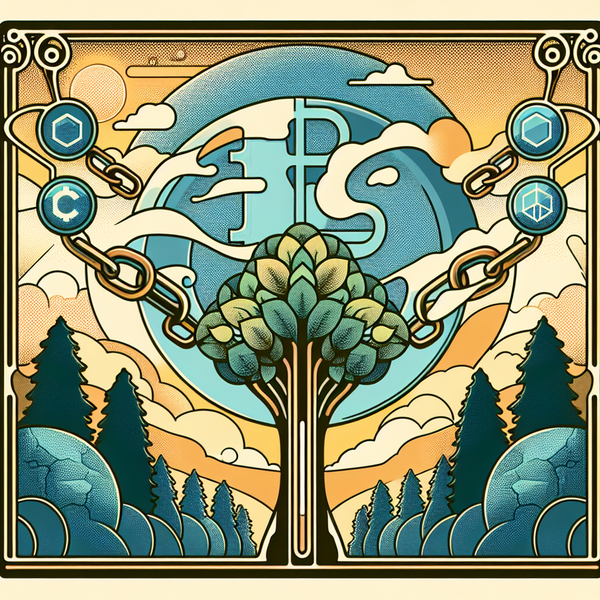The Yield Ladder Strategy: Building Consistent Income Streams Across Tokenized Real-World Assets

In the evolving landscape of digital finance, tokenized real-world assets (RWAs) have emerged as a compelling bridge between traditional investment vehicles and the innovations of blockchain technology. One particularly effective approach to managing these assets is the yield ladder strategy—a time-tested method reimagined for the tokenized future.
Understanding the Yield Ladder Concept
A yield ladder strategy—traditionally known in bond markets as a 'bond ladder'—involves building a portfolio with staggered maturity dates. Imagine a literal ladder: each rung represents an investment that matures at a different time. As each investment matures, you reinvest the proceeds at the top of the ladder, creating a perpetual cycle of maturing investments and reinvestment opportunities.
When applied to tokenized RWAs, this approach offers remarkable versatility and efficiency that traditional finance simply cannot match. After all, why climb a regular ladder when you could ascend on one made of tokenized gold? (Though I wouldn't recommend testing the physical properties of either.)
The RWA Duration Spectrum: Short, Medium, and Long
Tokenized real-world assets naturally fall into different duration categories, each offering distinct risk-reward profiles:
Short-Duration RWAs (0-12 months)
- Tokenized Treasuries: Platforms like Ondo Finance offer OUSG tokens, providing exposure to short-term U.S. treasury bonds with yields typically ranging from 3-5%.
- Invoice Factoring Tokens: These represent short-term business receivables, offering 5-8% yields with monthly or quarterly liquidity.
- Commodity-Backed Stablecoins: Gold-backed tokens like those available through Swarm provide inflation protection with modest yields of 1-3%.
Short-duration assets form the foundation of your yield ladder, providing liquidity and stability while sacrificing some yield potential. They're the financial equivalent of comfortable shoes—not particularly exciting, but you'll be grateful for them when the market starts running in unexpected directions.
Medium-Duration RWAs (1-3 years)
- Tokenized Corporate Bonds: Projects like Centrifuge offer exposure to mid-term corporate debt with yields ranging from 6-9%.
- Structured Products: Redbelly Network's tokenized financial products provide enhanced yields of 7-12% with quarterly or semi-annual distributions.
- Private Credit: Platforms like Goldfinch facilitate tokenized loans to businesses with 8-15% yields over 1-3 year terms.
These assets represent the middle rungs of your yield ladder, balancing reasonable liquidity with enhanced yields. They're the financial equivalent of a well-engineered suspension bridge—connecting your short and long-term financial objectives while absorbing market shocks.
Long-Duration RWAs (3+ years)
- Tokenized Real Estate: Platforms like Lumia enable fractional ownership in income-producing properties with potential yields of 8-15% over multi-year periods.
- Infrastructure Tokens: Representing stakes in long-term infrastructure projects with yields of 7-12% and significant appreciation potential.
- Tokenized Private Equity: Offering exposure to business growth with potential returns of 15-25% over 5+ year horizons.
Long-duration assets crown your yield ladder, providing maximum yield potential at the cost of reduced liquidity. Think of them as the penthouse suite of your portfolio—the views are spectacular, but the elevator takes a while to reach them.
Building Your RWA Yield Ladder: A Step-by-Step Guide
Let's construct a practical yield ladder across tokenized real-world assets:
Step 1: Establish Your Liquidity Requirements
Before climbing any ladder, you need to know how high you're comfortable going. Determine what percentage of your portfolio you need available within days, weeks, months, or years. This will dictate your allocation across duration categories.
For most investors, a sensible starting distribution might be:
- 30% in short-duration RWAs (0-12 months)
- 40% in medium-duration RWAs (1-3 years)
- 30% in long-duration RWAs (3+ years)
Step 2: Select Complementary RWA Tokens Within Each Duration Category
Diversification isn't just about duration—it's also about asset type. Within each category, select tokens representing different sectors and risk profiles:
Short-Duration Portfolio Example:
- 15% in OUSG (tokenized short-term treasury ETF) for baseline stability
- 10% in invoice factoring tokens for enhanced yield
- 5% in gold-backed tokens for inflation protection
Medium-Duration Portfolio Example:
- 15% in tokenized corporate bonds across diverse industries
- 15% in structured products on Redbelly Network
- 10% in private credit allocations via Goldfinch
Long-Duration Portfolio Example:
- 15% in tokenized real estate tokens with quarterly distributions
- 10% in infrastructure tokens with semi-annual payouts
- 5% in tokenized private equity with growth potential
Step 3: Implement Staggered Entry and Reinvestment Cycles
The magic of a yield ladder is in its timing structure. Instead of deploying capital all at once:
- Divide each duration allocation into equal tranches (ideally 3-4)
- Deploy these tranches at regular intervals (monthly or quarterly)
- As short-duration assets mature, reinvest selectively across the ladder
- When medium-duration assets mature, evaluate reinvesting at the long end
This approach ensures you're continuously capturing new yield opportunities while maintaining your target allocation. It's like having a financial escalator running alongside your ladder—providing alternate routes to your destination as market conditions change.
Step 4: Optimize for Gas Efficiency and Management Overhead
RWA tokens live on various blockchain networks, each with different gas fee structures and management requirements. To minimize costs:
- Batch Transactions: Consolidate token purchases, stake/unstake operations, and reinvestments to minimize separate transaction fees
- Leverage Cross-Chain Solutions: Utilize bridges like Redbelly Network's cross-chain functionality to minimize gas fees when transferring between ecosystems
- Automate Where Possible: Use yield aggregators and auto-compounding vaults that automatically reinvest distributions
- Choose Gas-Efficient Platforms: Prioritize platforms with fixed or predictable gas costs like Redbelly Network (currently priced at $0.026 per RBNT)
Consider setting calendar reminders for major distribution dates to batch related transactions. After all, nothing ruins the yield-ladder experience like discovering you've spent half your earnings on gas fees. That's like paying the ladder manufacturer every time you climb a rung.
Case Study: A Practical RWA Yield Ladder Implementation
Let's examine a hypothetical $100,000 portfolio using this strategy:
| Asset | Platform | Allocation | Expected Yield | Duration |
|---|---|---|---|---|
| OUSG (Treasury ETF Token) | Ondo Finance | $15,000 | 4.2% | 0-6 months |
| Invoice Factoring Tokens | Centrifuge | $10,000 | 7.5% | 1-3 months |
| Gold-Backed Tokens | Swarm | $5,000 | 2.0% | On demand |
| Corporate Bond Tokens | SwarmX | $15,000 | 8.3% | 2 years |
| Structured Products | Redbelly Network | $15,000 | 9.7% | 1.5 years |
| Private Credit | Goldfinch | $10,000 | 12.1% | 3 years |
| Real Estate Tokens | Lumia | $15,000 | 11.5% | 5 years |
| Infrastructure Tokens | Mantra Chain | $10,000 | 9.8% | 4 years |
| Private Equity Tokens | Nexera | $5,000 | 18.0% | 7 years |
This portfolio has a weighted average yield of approximately 9.1%, with distributions spread across multiple time horizons. The short-duration segment provides regular liquidity for reinvestment or emergencies, while the longer-duration assets maximize total returns.
Management Overhead Reduction Strategies
To minimize the time and complexity of managing this portfolio:
- Consolidate Platforms: When possible, choose platforms that offer multiple asset types. For example, Redbelly Network supports various forms of tokenized assets, reducing the need to manage multiple accounts.
- Automate Reinvestment: Use smart contract-based reinvestment protocols that automatically deploy matured funds according to your specifications.
- Create a Transaction Calendar: Schedule your interaction with the portfolio around key distribution dates to minimize separate login sessions and gas expenditures.
- Leverage Portfolio Tracking Tools: Utilize multi-chain portfolio trackers to monitor your positions without actively logging into each platform.
The goal is to spend more time enjoying the fruits of your yield ladder and less time maintaining it. After all, what's the point of building a beautiful ladder if you're too exhausted from construction to enjoy the view from the top?
Risks and Considerations
Even the most carefully constructed yield ladder isn't without its challenges:
- Smart Contract Risk: Diversify across multiple protocols to mitigate the impact of potential exploits
- Regulatory Uncertainty: Monitor evolving regulations that could impact tokenized RWAs
- Liquidity Premiums: Be aware that longer-duration assets may trade at discounts if you need to exit before maturity
- Counterparty Risk: Evaluate the entities behind tokenized assets, particularly for credit and structured products
- Oracle Failures: Consider how price feeds and external data sources impact your chosen tokens
Mitigate these risks through proper diversification, regular portfolio reviews, and staying informed about platform developments. A good yield ladder requires maintenance—just like a real ladder, you don't want to discover structural issues while you're halfway up.
Conclusion: The Future of Yield Architecture
The tokenized RWA yield ladder represents perhaps the most elegant fusion of traditional financial wisdom with blockchain innovation. By strategically positioning investments across the duration spectrum, investors can create resilient income streams while maintaining sufficient liquidity for opportunities and emergencies.
As the RWA tokenization trend accelerates—projected to reach $16 trillion by 2030—the tools available for constructing these yield ladders will only improve. Platforms like Redbelly Network, Lumia, Swarm, and others are continuously enhancing their offerings, reducing frictions, and expanding the accessible asset universe.
The truly revolutionary aspect of this strategy isn't just its adaptation to blockchain, but rather how tokenization removes historical barriers that made traditional yield ladders impractical for most investors. Fractional ownership, programmable distributions, and cross-chain interoperability combine to make sophisticated income strategies accessible to everyone.
Perhaps it's time we updated that old financial adage: it's not just about time in the market, but about building a ladder that reaches across time in the market.




